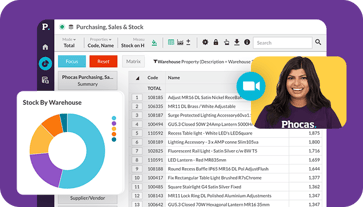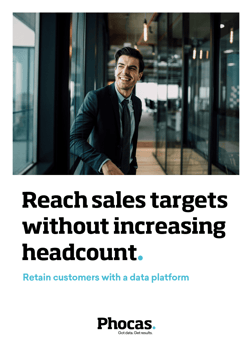Business Intelligence vs. CRM: Which one is best for you?

There is an ongoing debate on whether Business Intelligence (BI) or Customer Relationship Management (CRM) is more effective in helping a business succeed. The software comparison happens because BI and CRM tools share a number of the same functions – most notably in using historical data to identify key trends that businesses can leverage to their advantage. The truth is, there is value in both depending on your business goals.
However, industry experts are still at odds in determining the best business intelligence solution for businesses. In this blog, we take on this long-standing battle between BI and CRM, discuss the key differences, the impact of artificial intelligence on both so you can determine the best tools for your business.
Business Intelligence and CRM Software: What is the difference?
BI tools and CRM tools were built for different purposes.
BI was developed with a strategic need in mind – the need for intelligence that informs business decisions. As businesses face unstable economic conditions or more competition, knowledge becomes a source of success. With the evolution of technology, the size of organizational and customer data grew at an exponential rate making this unstructured data hard to interpret. BI was created in order to rationalize large volumes of data into reports that deliver insights about the past and future conditions. These practical findings help business people to address real issues such as a decline in profitability for some products or channels with poor conversion rates. The analysis side of BI can also include external information like industry benchmarks for comparison with your KPIs. BI is focused on the business as a whole, with users being also able to drill into specific metrics of the business data to guide certain areas of the business.
CRM, on the other hand, is more consumer-centric. It is referred to as a complete system that helps a business execute almost every part of the customer experience, from marketing, sales, social media, support and service. With tight competition, business goals went beyond making a sale and towards retaining customers. Soon, business leaders knew they needed to create better customer relationships to survive in the market. There was an unmistakable need for better customer service and later, customer experience. Since then, CRM has been leveraged by business people to help them build better customer relationships. CRM data is very important and can help a business retain loyal customers. Thia data can be incorporated in your BI tool, alongside other aspects that affect business growth, allowing for a comprehensive and real-time view of all aspects of your business.
Multiple vs. single data source
Both BI and CRM tools are equipped with advanced reporting capabilities, but they differ in their capabilities to source data.
BI tools have been known for their ability to draw data from multiple sources to build comprehensive reports that combine CRM, financial and operational data. They are also able to consolidate several types of data points to deliver clear reports. Since BI is equipped with visualization capabilities, these reports can be presented in charts, graphs or infographics that help the user efficiently identify trends and draw insights from the data.
CRMs, however, are capable of accessing data stored only in connected databases. Furthermore, older CRMs were only able to source data stored in their very own database. If data is stored in an external database, the data cannot be used in CRM reporting. However, more solution providers are developing advanced CRMs that have the ability to integrate with several databases, in order to make the CRM become a single source of data. As a result, more businesses have used CRM integration to optimize reporting capabilities.
What skills are need for each software?
With some BI software, a business needs a skilled analyst with a strong business background to manage the data, pull the reports and identify the trends. Other options are more intuitive and once the implementation is complete, people of all skill levels can use it.
CRM typically informs people who are focused on sales or marketing. Reporting and customizing the tool may be more straightforward for these data focused roles, but there’s more to CRM than reporting. You need a skilled salesperson or marketer to truly leverage the tool to achieve greater customer satisfaction.
What about using a platform that has data analytics + CRM and FP&A in one?
The creation of tools that address multiple needs has become more critical to avoid working between 10 different systems. Platforms combining data analytics, CRM, and FP&A (Financial Planning and Analysis) that sit over the top of ERP systems are available. These platforms allow users to pull data from many sources like customer interactions, operational data and business performance so everyone in the company can get actionable insights relevant to their job roles.
The advantage here lies in connectivity or collaboration. For example, the shared data means budgets and forecasts can be created in the system and can include data from the CRM, sales team or pricing to inform the strategic planning. These can also be checked with actuals and automatically update performance dashboards. Management reports can also be created specifically to measure your key performance indicators.
A single platform eliminates data silos helping with data consistency and faster decision-making. If you run a manufacturing, distribution or retail business, this type of system will cover all areas as you can analyze sales, inventory or production and use the consolidated data to plan better while ensuring customer relationship management informs all actions.
Artificial intelligence (AI) is reshaping how businesses utilize CRM and BI. In CRM, AI enhances customer segmentation, for more targeted marketing campaigns by analyzing customer behavior patterns. Predictive analytics powered by AI helps businesses anticipate customer needs, resulting in more proactive customer service. Plus new AI agents or assistants are being trialed in some CRM systems and are designed to help sales people with their data entry, follow-up emails and to schedule appointments so they can better focus on high-value customer interactions.
In BI, AI is being tasked with reviewing vast datasets and identifying trends that may not be immediately apparent to human analysts. At Phocas, the AI in BI helps train the new users to data analytics and query their data by typing in questions. Phocas integrates AI to support human judgment, not to override it. This approach ensures that business people can use the power of AI while maintaining the flexibility and creativity of human experience.
What does this mean for you?
The choice of BI vs. CRM depends on the goal you want to accomplish. For an objective centered around your customers’ experience, CRM is the way to go. For a complete business-focused analysis involving many parts of your business and external factors, BI is the answer. For those looking for an all-encompassing operational and financial approach, a platform combining BI, CRM, and FP&A might be the solution.
Regardless of the option you take, all solutions are based on the concept of data automation to help you leverage insights for more informed decisions and ultimately achieve business growth.

Empowering businesses with intuitive data analytics, driving informed decisions for growth and profitability. We make people feel good about data.

We'll do the data wrangling, you do the analyzing
In today’s business world, we are faced with the constant struggle to bring our data into line. The sheer volume of data that businesses generate can be overwhelming to simply manage, never mind analyze. A survey by Phocas revealed that 60% of businesses identified ‘no expertise in-house,' and 33% said, ‘too much data to unravel' as the main obstacles that prevent them from breaking down data silos.
Read more
Phocas secures 37 top rankings in BARC's 2023 BI + Analytics Survey
The voice of the BI and analytics community has officially spoken following the release of The BI & Analytics Survey 23 by software selection and strategy experts, BARC last week.
Read more
Phocas Products Now on Sage Intacct Marketplace
Phocas Software helps Sage customers gain more insights from their business Phocas Software, a business planning and analytics platform for sales, operations, and finance teams, announced a new technology partnership with Sage, the leader in accounting, financial, HR, and payroll technology. Phocas products are now integrated with Sage Intacct, making it easier for companies to access, analyze, report, and share information in their systems.
Read more
The data trends you need to know for 2022
With the new year well underway, it looks like organizations will be facing another roller-coaster year of change.
Read more
Find out how our platform gives you the visibility you need to get more done.
Get your demo today